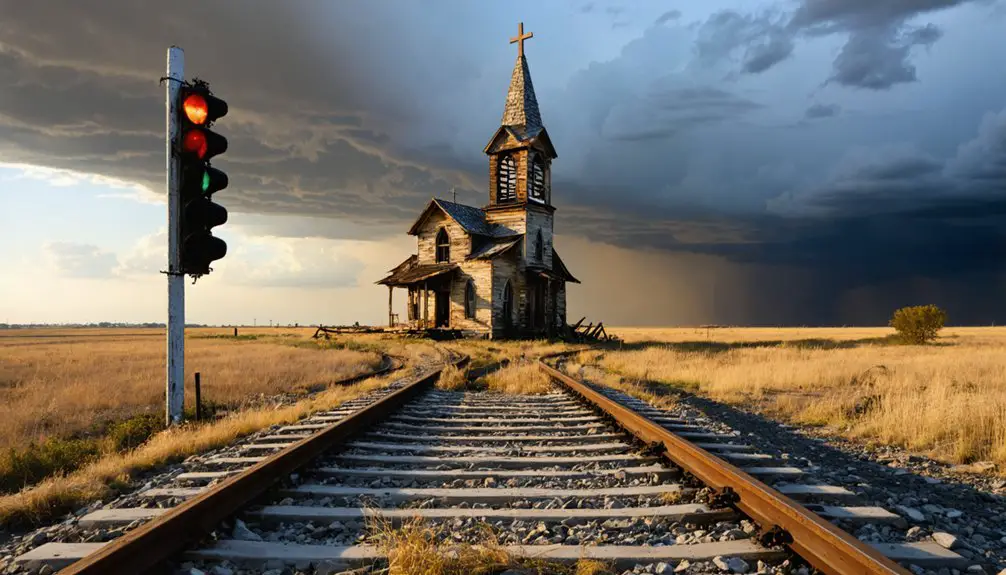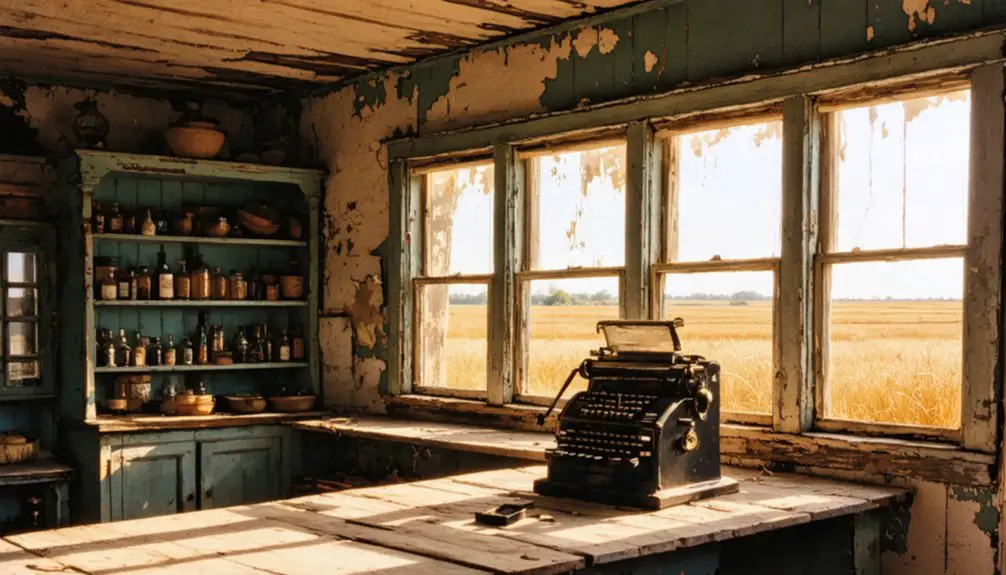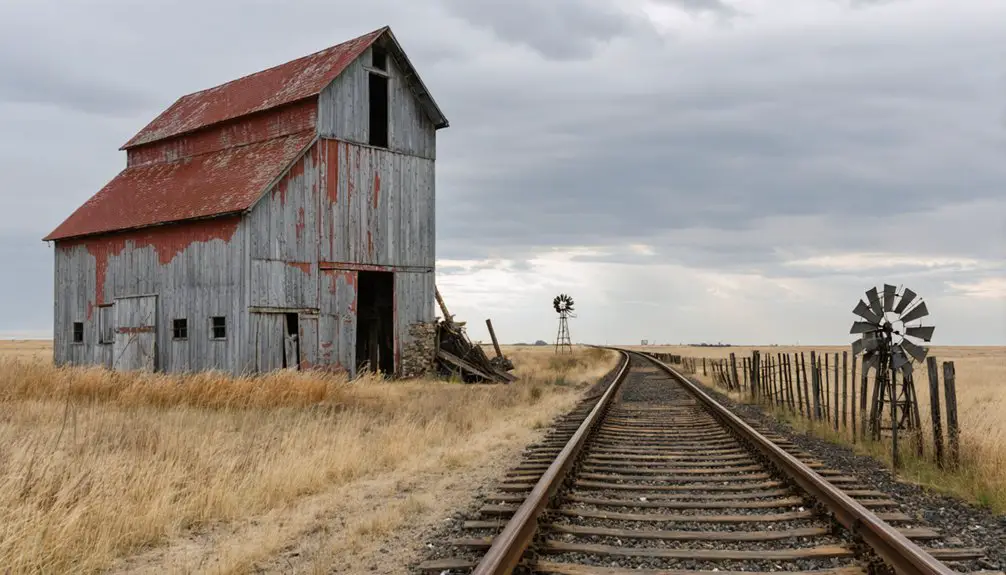You’ll find Sidney’s remnants along the Union Pacific Railroad line that reached Kansas in 1867. This strategic division point flourished as the last rail stop before the frontier, serving military supplies, buffalo hides, and wool trade. The town bustled with roundhouses, warehouses, and tight-knit neighborhoods of railroad workers’ families. Though Sidney later declined due to economic shifts and rural exodus, its story captures the rise and fall of America’s frontier settlements.
Key Takeaways
- Sidney emerged as a strategic railroad division point in 1867 when the Union Pacific Railroad reached Kansas.
- The town served as a vital freight forwarding hub for military supplies, buffalo hides, and wool during western expansion.
- Economic decline began after losing a county seat bid and being bypassed by new transportation routes.
- Agricultural mechanization and rural-to-urban migration led to population loss and eventual abandonment.
- The ghost town’s remains serve as a case study for understanding economic stagnation and rural decline patterns.
The Birth of a Railroad Settlement
When the Union Pacific Railroad reached Kansas in 1867, Sidney emerged as a strategic division point that would shape the region’s development.
You’ll find that railroad innovations quickly transformed the empty prairie into a bustling settlement, as the company laid out the townsite and constructed essential facilities like roundhouses and support buildings. Military protection from Fort Sidney ensured the safety of construction crews and railroad operations.
The settlement patterns followed a practical approach – early structures were repurposed from nearby ranches to meet immediate needs, while hotels, general stores, and saloons sprang up to serve the influx of railroad workers and travelers. The first building was a French Louis ranch that was converted into a whisky saloon.
Sidney’s population swelled to roughly 1,000 residents as it evolved into a significant freight and stage station. The town’s strategic location made it a critical gateway to the Black Hills and western territories, solidifying its role in America’s westward expansion.
Early Pioneers and Town Founders
The early pioneers who shaped Sidney’s foundation remain largely shrouded in mystery, with limited historical records documenting their specific identities and origins.
Like many Kansas settlements of the era, Sidney’s founders likely came from Eastern states, bringing their diverse cultural influences and determination to build a new life on the frontier.
These settlers faced numerous pioneer challenges, from harsh weather conditions to establishing basic infrastructure.
You’ll find parallels with other Kansas ghost towns, where settlers worked to create communities centered around railroad access, general stores, and agricultural ventures.
Similar to the Andrew Reed family who first settled Thomas County in 1879, early pioneers sought opportunities in the region’s promising farmland.
Historical records show settlers from Pennsylvania and New Jersey organized the initial settlement of the region.
While the ethnic makeup of Sidney’s pioneers isn’t well-documented, they were part of a broader migration that included various European backgrounds, contributing to Kansas’s rich cultural mosaic during its early settlement period.
Life Along the Tracks
If you’d lived in Sidney during its railroad heyday, you’d have witnessed the daily rhythms of railroad workers maintaining tracks, loading freight, and servicing steam locomotives at regular intervals.
The station stop drew a steady stream of travelers and commerce, transforming the trackside area into a bustling hub of activity where merchants and service providers set up shop to meet the needs of both railroad employees and passengers. Some travelers arrived in classic Sheridan automobiles, which were among the unique American vehicles seen during the 1920s. The Santa Fe Railway made history here when its Scott Special train achieved record-breaking speeds of up to 106 mph in 1905.
Railroad workers’ families gradually established homes near the tracks, forming tight-knit neighborhoods that relied on the predictable patterns of train schedules and railroad operations.
Railroad Workers’ Daily Routines
Life along the railroad tracks in Sidney demanded unwavering dedication from workers who faced grueling conditions and constant dangers.
You’d find brakemen climbing atop moving cars to manually apply brakes, exposed to brutal weather while perched on metal ladders. Their duties required quick responses during emergencies and airbrake failures.
Locomotive engineers operated from open platforms, battling smoke and steam while mastering every curve and grade change along their routes. The dangerous flying switch maneuver caused numerous accidents as brakemen attempted to jump between moving cars. The flagman’s signals were crucial for directing train movements and preventing collisions.
They’d coordinate with crew members through a complex system of hand signals and whistles, regardless of weather conditions. You couldn’t escape the toxic fumes in tunnels or the constant risk of injury.
Working the rails meant enduring irregular hours, performing physical labor, and maintaining vigilance through long shifts – all without modern safety protections.
Station Stop Community Growth
During Sidney’s heyday as a railroad station stop, rapid development transformed the once-empty prairie into a bustling frontier hub within weeks.
The station stop significance became clear as businesses sprang up to serve the steady stream of travelers, freight workers, and railroad crews. You’d have found general stores, warehouses, and saloons lining the tracks, while water towers kept the steam locomotives running on schedule. Like the town of Santa Fe which failed after the railroad declined service, Sidney’s community relied heavily on rail transportation.
The community dynamics reflected the diverse mix of merchants, buffalo hunters, and railroad staff who called these frontier towns home.
While churches and social structures would come later, the early days were marked by a more rough-and-tumble atmosphere. As with many railroad towns, Sidney’s population swelled during construction, creating a temporary boom that supported wholesale trade and essential services for westbound travelers.
Commerce and Industry in Sidney’s Heyday
If you’d visited Sidney during its peak, you would’ve found a bustling railroad station where grain elevators stood ready to load crops onto Missouri, Kansas & Texas Railway cars.
The station housed express offices and telegraph services, enabling merchants to coordinate shipments and handle business transactions with larger commercial hubs like Cimarron.
Local merchants operated multiple businesses along the tracks, including general stores that supplied farming equipment, blacksmith shops that repaired agricultural tools, and other essential services that supported Sidney’s agricultural economy. Like many early Kansas settlements, the town faced challenges from environmental factors like drought, which ultimately impacted its long-term survival.
Railroad Station Operations
When Sidney became the western terminus of the Union Pacific Railroad Eastern Division in 1868, it quickly transformed into an essential freight hub connecting rail and wagon transport across the frontier.
Railroad logistics centered around extensive warehouses and freight operations facilities that handled cargo bound for the Santa Fe Trail and Fort Lyon via a 120-mile wagon road.
You’d find bustling loading platforms and stockyards where merchandising firms transferred military supplies, buffalo hides, furs, and wool between trains and wagons.
The station’s infrastructure supported the constant flow of goods and supplies crucial to western expansion.
When construction paused from August 1868 to 1869, Sidney’s role as a freight forwarding point intensified, with countless traders and buffalo hunters relying on its position as the last rail stop before the untamed frontier.
Local Merchant Activities
Sidney’s commercial heart beat through a network of enterprising merchants who operated diverse businesses crucial to frontier life. You’d find these savvy entrepreneurs employing merchant strategies that involved controlling multiple enterprises – from general stores stocked with imported goods to blacksmith shops serving both settlers and cattlemen.
Their stores often doubled as post offices, making them critical communication hubs for the community.
The trade dynamics reflected the needs of a growing frontier town. Local merchants didn’t just sell goods; they became community leaders who helped establish churches and schools.
They operated butcher shops for local meat processing and provided indispensable services through harness shops and hardware stores. Despite facing challenges like occasional robberies due to sparse law enforcement, these merchants created a commercial foundation that sustained Sidney’s early growth.
The Heart of Community: Churches and Schools

During the late 19th century, churches and schools emerged as the beating heart of frontier communities like Sidney, serving as more than just places of worship and education.
These buildings became true church community centers, where you’d find post offices, social gatherings, and cultural celebrations happening under one roof. Immigrant settlers, from German Mennonites to Jewish families, established their own places of worship, creating a diverse tapestry of faith practices across southwest Kansas.
The educational legacy of these frontier settlements lives on through the remnants of their schoolhouses, which were often among the first buildings constructed.
You’ll find that these institutions adapted to serve multiple purposes, with many church basements doubling as classrooms and community meeting spaces, showcasing the resourcefulness of early Kansas settlers.
Transportation Hub and Economic Growth
As you explore Sidney’s railroad history, you’ll find its essential role as a water stop where steam locomotives could replenish their supplies while tackling challenging grades in the region.
The Missouri, Kansas & Texas Railway’s water tower operations transformed Sidney into a crucial transportation hub, enabling trains to maintain their schedules and continue their journeys across Kansas.
This strategic position sparked the growth of local commerce, with businesses like general stores and agricultural trading posts establishing themselves to serve both the railway workers and area farmers who brought their goods to market.
Railroad Water Stop Operations
The strategic placement of railroad water stops transformed countless frontier outposts into vital transportation hubs, and Sidney was no exception. Steam locomotives required consistent water supply access, with tenders needing 2,600 to 3,600 gallons to maintain power over long routes.
You’ll find these vital operational features at water stops like Sidney:
- Elevated wooden or steel tanks providing gravity-fed water via spouts that firemen operated.
- Large hand-dug wells with stone rims and protective roofs, feeding pump houses that moved water mechanically.
- Infrastructure that supported both scheduled refills and emergency stops without disrupting major terminal operations.
These water stops didn’t just serve trains – they attracted goods and passenger traffic, stimulating local economies through labor markets for well digging, pump maintenance, and tank construction.
Local Commerce Hub Development
Sidney’s transformation into a bustling commerce hub exemplified how frontier railroad stops evolved into crucial economic centers.
You’ll find that local trade flourished around the convergence of transportation routes, where general stores, supply shops, and post offices created a vibrant commercial ecosystem. The town’s economic resilience depended heavily on serving both agricultural producers and freight operators, facilitating the exchange of grain, livestock, and crucial goods.
As merchants expanded their businesses to meet growing demands, Sidney developed the hallmark features of a thriving Kansas commerce center – grain elevators, blacksmith shops, and mercantile establishments.
However, like many frontier towns, Sidney’s prosperity remained tethered to its transportation advantages. When evolving logistics infrastructure shifted trade routes elsewhere, the town’s commercial importance began to fade, ultimately leading to its decline.
The Beginning of the End

When local leaders lost their bid to secure the county seat, Sidney’s fate took a decisive turn toward decline.
The economic impact rippled through the community as businesses relocated to more prosperous neighboring towns, and population dynamics shifted dramatically with the exodus of skilled workers and professionals.
You’ll find three main factors that accelerated Sidney’s downfall:
- Transportation routes bypassed the town, redirecting commerce and travel to competing communities.
- Agricultural mechanization and consolidation reduced local labor needs, shrinking the farming population.
- Young residents left for urban areas with better opportunities, leaving an aging population behind.
Without the county seat status and facing fierce competition from nearby growing towns, Sidney couldn’t maintain its role as a local commerce hub, setting the stage for its eventual transformation into a ghost town.
What Remains Today
Very little remains of Sidney’s once-bustling community, with only scattered foundation stones and overgrown street grids marking where buildings once stood.
If you’re interested in ruin exploration, you’ll find the site offers minimal visible structures, as nature has steadily reclaimed the former townsite. The old railroad lines nearby stand as silent witnesses to Sidney’s historical significance, though they’ve fallen into disuse.
While some isolated homes exist in the general area, the original town footprint has largely returned to agricultural land or wilderness.
You won’t find any operational businesses or services – the post office closed in 1888, and no public buildings remain standing.
The town’s memory lives on primarily through historical records and occasional ghost tours, though physical evidence continues to fade with each passing year.
Preserving Sidney’s Legacy

Dedicated preservation efforts have transformed how Sidney’s legacy endures through time, thanks to intensive documentation and surveying work conducted in 2015-2016.
Community initiatives, led by local institutions and residents, have strengthened preservation strategies through oral histories and property records.
You’ll find several key preservation approaches in action:
- The Nebraska State Historic Preservation Office oversees landmark designations while coordinating with county officials.
- Local museums and libraries maintain genealogical records and host educational exhibits.
- Digital mapping and documentation create detailed preservation plans to protect remaining structures.
You can participate in ongoing preservation work through volunteer opportunities at the Cheyenne County Museum or by contributing to oral history projects that keep Sidney’s story alive for future generations.
Learning From Lost Towns
Through detailed studies of Sidney and similar ghost towns across Kansas, researchers have uncovered important patterns that explain why some frontier communities thrived while others faded away.
You’ll notice that successful towns maintained diverse economic foundations rather than relying on single industries or transportation routes. Ghost town lessons repeatedly show that promises from investors and railroad companies needed firm commitments, as broken pledges often triggered community decline.
The keys to community resilience became clear: strong social infrastructure, adaptable local leadership, and sustainable access to essential resources.
When you examine Kansas ghost towns like Sidney, you’ll find that those lacking economic diversification or failing to adjust to changing transportation patterns couldn’t survive the broader rural-to-urban migration trends that transformed the Midwest.
Frequently Asked Questions
Were There Any Notable Crimes or Outlaws Associated With Sidney?
You won’t find documented crime history or outlaw legends specifically tied to Sidney. While nearby Kansas towns had their share of frontier violence, Sidney’s records don’t show any notable criminal activity.
What Native American Tribes Originally Inhabited the Sidney Area?
Like ancient guardians of the prairie winds, you’d find the Pottawatomi and Kanza (Kaw) tribes originally claimed this land, their tribal history and cultural significance deeply woven into the region’s early identity.
How Did Weather Patterns and Natural Disasters Affect Sidney’s Development?
You’ll find that harsh droughts severely impacted Sidney’s farming economy, while floods damaged essential infrastructure. These recurring natural disasters disrupted rail transport and farming, ultimately accelerating the town’s decline into abandonment.
Did Sidney Have Any Significant Minority or Immigrant Populations?
Drawing a blank on this one, you won’t find substantial evidence of immigrant contributions or cultural influences in Sidney. It’s population stayed relatively homogeneous, consisting mainly of European-descended settlers and railroad workers.
What Were the Most Common Occupations for Women in Sidney?
You’d find women primarily engaged in domestic services like cooking, laundry, and childcare, while others contributed through textile production – sewing, quilting, and weaving goods for their families or trade.
References
- https://legendsofkansas.com/skiddy-kansas/
- https://www.visitgck.com/eminence-and-ravanna-the-story-of-finney-countys-ghost-towns/
- https://www.youtube.com/watch?v=0wTaBKVg3dk
- https://legendsofkansas.com/kansas-ghost-town-list/
- https://en.wikipedia.org/wiki/List_of_ghost_towns_in_Kansas
- https://www.fortsidney.org/stories-of-fort-sidney/fort-sidney-key-to-the-transcontinental-railroads-success
- http://www.kancoll.org/books/andreas_ne/cheyenne/cheyenne-p2.html
- http://old.atsfrr.org/resources/burton/sk.htm
- https://fhsuguides.fhsu.edu/kansasheritage/nortoncounty
- https://dpcountyks.com/doniphan-county-history/



